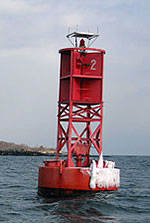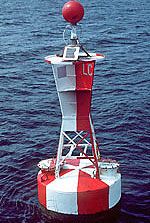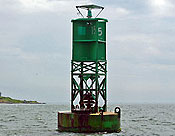 Lighted Buoy 2 at the entrance to the Piscataqua River on the ME/ NH border. Photo by Bob Trapani, Jr. Lighted Buoy 2 at the entrance to the Piscataqua River on the ME/ NH border. Photo by Bob Trapani, Jr. |
“The modern buoys would probably have seemed magical to the navigators of the past centuries. What, for instance, would Henry Hudson, on entering the “mouth of that land,” have thought of the floating buoy far out to sea, which automatically turns on its own light at sunset and extinguishes it at daybreak?” – Francis A. Collins, Sentinels Along Our Coast, 1922
The public’s perpetual affection for the regal lighthouses that stand along America’s vast coastlines is deeply rooted within a benevolent mission that speaks of enduring vigilance. These beacons of the sea never fail to conjure up countless images of strength, safety, romance and mystery as they inspire the landlubber and safeguard the seafarer. Yet this deep-rooted admiration for lighthouses seldom translates into a similar appreciation for the shining sentinel’s little brother – the lighted buoy.
 |
|
| Lighted buoys are like the “Little Brothers” of lighthouses. (Pictured is Tongue Point Lighthouse, CT). Photo by Ron Foster. |
The mission of the lighted buoy – a sort of miniature lighthouse, is quite similar to its taller counterparts in that it too shines a light, and often sounds a fog signal as well, to help safeguard navigation. And just like a lighthouse, a lighted buoy is a proven lifesaver for those who go down to the sea. But despite these favorable comparisons, there remains a deep chasm that separates the lighthouse and lighted buoy when it comes to the public’s ability to understand and respect these dancing lights of the sea.
It is true that the lighted buoy doesn’t possess the stately presence of a towering lighthouse, nor is it adorned in a colorful or elegant daymark. And no, its guiding light doesn’t carry near as far on the horizon as that of a lighthouse, but these warriors of the sea are extremely valuable nonetheless. Ask any old salt, fisherman or professional mariner who makes a living on our nation’s waterways, or a recreational boater who has been saved from a sea-borne calamity by the presence of one of these floating beacons, and each will tell you that the lighted buoy is a good friend.
| Carmanah LED beacons now light many buoys throughout America’s waterways. Photo by USCG. |
Despite their humble appearance, which often contains a healthy dose of sea growth on its rugged hull and a spattering of bird guano throughout its tower, the lighted buoy has secured a rightful spot in the annals of America’s maritime heritage. In fact, lighted buoys have one up on the lighthouse when it comes to navigational value – they can and have gone where lighthouses dare not venture. “Lighted buoys play an important role in marking wrecks, shoals and hazards in places were fixed structures and markers are not viable options,” says BMC Mike Baroco, Jr., USCG (retired). “Many offshore shoals and hazards in areas heavily traveled by mariners warrant a constant sentinel, and lighted buoys fill that role.”
BMCM Dennie Dever, USCG (retired) echoes this sentiment, noting “Buoys are the most versatile element of any ATON scheme. There are some places where fixed aids, i.e. daybeacons or lights on pilings are adequate. But for those numerous places where channels perpetually change, or the water is too deep, only a buoy will do. So locations that require buoys can be the more challenging areas to navigate.”
 A classic picture of a lighted buoy outfitted with a red daymark atop its tower. Photo by USCG. A classic picture of a lighted buoy outfitted with a red daymark atop its tower. Photo by USCG. |
Dever goes on to say, “A lighted buoy usually marks the entrance to a channel, an obstruction, a turn, or a bifurcation (or “Intersection” for the landlubbers). Lighting these risky areas makes them more obvious at night, and illustrates a visual picture to confirm the information on the nautical chart that all prudent mariners use. In an age where boaters spend more time gawking at their electronic chart plotter than looking out the window, a carefully placed lighted buoy proves that seeing is believing, especially at night, or in fog, rain, or snow.”
As many people know, an aid to navigation like a lighthouse doesn’t protect mariners with its guiding beam just under the cover of darkness. These sentinels also warn and guide the mariner during daylight hours as well by showing a distinctive daymark, which consists of the tower’s color-scheme and construction design. A lighted buoy performs the same function as BMC Baroco points out, saying, “They offer a visual aid that can be easily identified during both daylight and darkness, and they offer a larger target for radar to acquire than unlit buoy hulls.”
The practicality of a lighted buoy is an invention that is only 124 years old, as the first permanent lighted buoy, which was lit by compressed gas, finally became a reality in 1882. Today, lighted buoys are illuminated by solar power and range in size from the massive 9 x 35 seagoing steel buoy that possesses a focal plane of 20 feet, 7 inches and weighs 18,500-pounds, to the small foam buoys that weigh between 115 to 1,100-pounds depending on their size.
 Buoys often mark areas where lighthouses would not be feasible.. Photo by Jeremy D’Entremont. Buoys often mark areas where lighthouses would not be feasible.. Photo by Jeremy D’Entremont. |
A side note that is worth mentioning when touching on buoys is the uncanny ability to serve as a “magnet” for all types of muck & mire that inevitably affixes itself to the hulls of these floating markers – lighted or unlighted. BMC Baroco, who served aboard the USCGC HORNBEAM in the 1980s, recalls this inherent buoy trait from his days of working “traffic lights” of the sea. According to Baroco, The “tube” or counterweight on the larger lighted whistle buoys is hollow, which permits sea growth to enter these tubes. As might be expected, the sea growth could get rather severe between inspections.”
Baroco went on to say, “Shooting the tube, as we called it, was one of the more, least desirable jobs on the deck of a buoy tender. Needless to say, whoever had the cleanest rain suit, or coveralls – usually the new guys, normally received this ‘lovely’ task. But out of courtesy more than a few times, yours truly took a dive into the tube to speed up the evolutions…had to run out of new folks at some point you know!”
These dancing lights of the sea bob and dip in choreographed fashion on the whim of the winds and tides, all the while remaining on station to send out the light for those seafarers seeking the nautical knowledge that their color, number and light characteristics convey. Lighted buoys, much like wave-swept offshore lighthouses, also take on the terrifying tempest, ravaging ice floes and on occasion, the frightening impact of a passing vessel that strays off course and collides with the floating guidepost.
Through it all, the lighted buoy remains the all-important ‘little brother’ to America’s majestic lighthouses. These mobile and sturdy navigational aids shine their guiding lights in the trenches, where storm-driven air meets the power of turbulent seas in an effort to protect mankind – a mission that cannot be carried out by a lighthouse – but only the humble lighted buoy.
Created: September 2006
Did you know?
- According to historian, Amy K. Marshall, “In 1851, Charles Babbage, of London, published a paper about putting lights on buoys. It would be another 20 years before technological advances could make lighted buoys a reality in the United States.”
- The first lighted gas buoy was temporarily established in 1881 near the Scotland Lightship. The first permanent lighted gas buoy was established a year later in 1882 within New York Bay.
- The United States Lighthouse Board authorized the test of a Foster Gas Lighted Buoy in Delaware Bay, which was patented by J.M. Foster and his company (United States Beacon Light and Signal Company) on July 11, 1882. According to the company, “To practically exhibit the workings of the Foster Buoy, one of the structures was on July 1st, 1882, placed in the Delaware River, where it remained burning continuously until October 1st, when, by authority of the United States Lighthouse Board, it was moored near the Fourteen Foot Bank Light Vessel, in Delaware Bay, a most exposed position, and it there remained until November 15, 1882 when the gas became exhausted.”
- The November 22, 1890 edition of the Denton Journal of Denton, Maryland, ran a small article entitled, “Luminous Buoy.” According to the news report, “Experiments have been made at Havre (de Grace) with a luminous buoy invented by M. Dibos. The buoy emits the light which is produced by phosphide of calcium on reaching the water; and as it is very powerful, the sea being illuminated for a considerable distance around. Spectators in the lighthouse at Havre (de Grace) saw the glare distinctly at a point two and a half miles away, and it is plainly visible for over five miles.”
- Electricity was used as an experimental illuminating source for lighted buoys from 1888 to 1903. The electrical buoy experiment occurred along Gedney’s Channel in New York Harbor and was lit by a submarine cable connected to a generator at Sandy Hook, NJ.
- The United States Lighthouse Service began experimenting with acetylene gas in lighted buoys in 1904. Two such buoys were finally placed in service during 1906.
- The Lighthouse Service: Its History, Activities and Organization by George Weiss in 1926 notes that in 1880 the United States did not have any lighted buoys. Thirty years later the U.S. Lighthouse Service deployed only 225 lighted buoys nationwide.
- USLHS Commissioner George Putnam once noted that “The Peaked Hill Bar gas and whistle buoy off Cape Cod, on one charge of compressed acetylene gas burned from April 22, 1913, to October 8, 1914, – very nearly one and one-half years, – without being extinguished during this period. It was a light of three hundred and ninety candle-power, and is reported to have been seen twenty miles.”
- The United States Lighthouse Service deployed over 1,700 lighted buoys along America’s coastlines and inland waters during the mid-1930s.
- According to a Historic American Engineering Record on buoy tenders, “More efficient, not to mention safer, electrical lighting systems relying upon batteries started to supplant the standard acetylene gas powered lights in the 1950s.” The report went on to note that “Primary 12-volt batteries in use would remain charged up to three years depending on the size of the lamp and characteristic.”
- The U.S. Coast Guard experimented with the use of atomic power to illuminate a buoy in the 1960s. Historian Amy K. Marshall notes, “It was tested in Baltimore Harbor in 1961 and was quietly removed in 1966 after reports that the nuclear generator failed to keep the buoy lit.”
- The Coast Guard discontinued all acetylene gas powered buoys by 1963.
- During the 1970s, the Coast Guard introduced large navigational buoys (LNBs), with many utilized as replacements for lightships. The LNBs were outfitted with a light, sound signal and often times a radiobeacon system as well.
- BMC Mike Baroco, Jr., USCG (retired) notes that “Prior to the mid 1980s, today’s GREEN buoys were painted BLACK with green retroreflective tape and green lanterns.”
- Solar power was introduced to buoys in 1984.
- A 1986 Coast Guard report in Engineering Digest noted, “Aids to navigation (ATON) units have now converted 5,000 aids to solar power and have reached the halfway point of the original goal of 10,000 conversions…Conversion of the aids from expensive primary batteries that contain mercury and are considered hazardous waste will save several million dollars. In addition, field units will have more flexibility while conducting ATON operations since they are no longer constrained by a strict recharge schedule.”
- BMC Mike Baroco, Jr., USCG (retired) recalls a historic moment, noting, “USCGC HORNBEAM set the first solar powered buoys in the Delaware Bay Entrance, during the summer of 1986.” (not the first in the US, just the first in the Delaware Bay).
- Solar powered light emitting diodes (LEDs) were introduced in the field as demonstration projects during the late 1990s, with the goal of having LED optics eventually replace the incandescent lighting system on lighted buoys and other aids to navigation.
- As of 2003, the U.S. Coast Guard had outfitted 16,405 of its total 16,800 lighted aids, with solar power (this number includes all federal lighted aids – not just buoys).
- The winter 2006 edition of the U.S. Coast Guard’s The Aids to Navigation Bulletin contains a feature by Mr. Son Nguyen, Commandant (CG-432A) entitled “Overview of LED Signal Projects. The article touches on the revolutionary LED beacon manufactured by the Victoria, British Columbia-based Carmanah Technologies. According to Nguyen, the Carmanah 700-Series LED Signals were “distributed to the field in 1999 and authorized for use on any platform, fixed or floating, requiring a 3 nautical mile light.” Nguyen went on to note, “Additionally, in 2004 we (U.S. Coast Guard) purchased enough Carmanah lanterns to replace 155mm lanterns on floating aids with 12 volt DC, 0.25 amp lamps.”